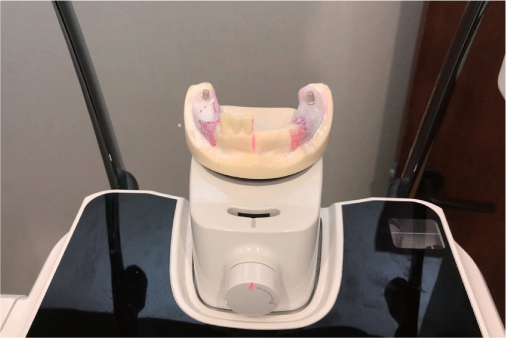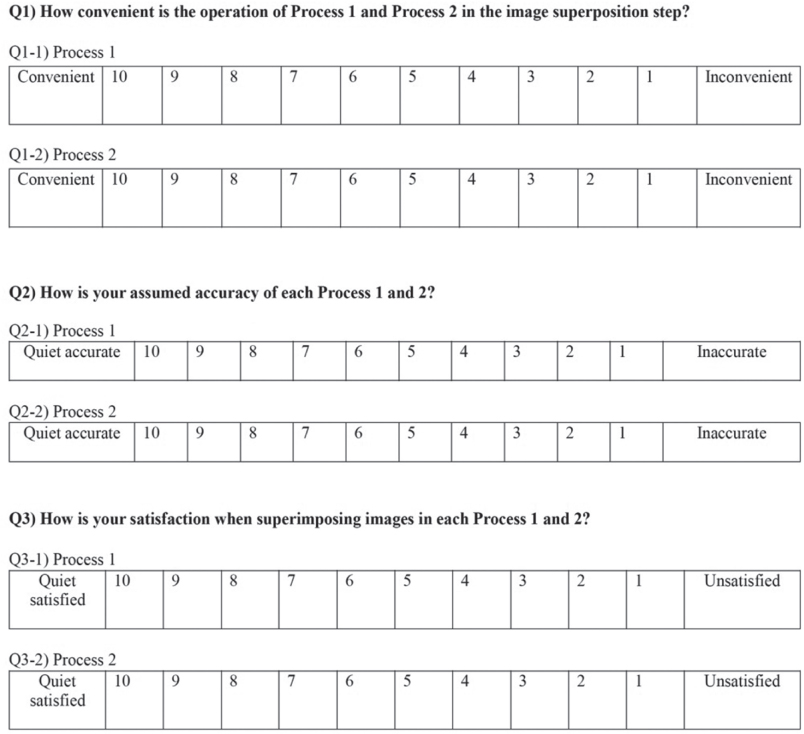J Korean Acad Prosthodont.
2019 Jul;57(3):219-224. 10.4047/jkap.2019.57.3.219.
Time efficiency and operator convenience of using a micro-screw in image registration for guided implant surgery
- Affiliations
-
- 1Department of Prosthodontics, School of Dentistry, Kyungpook National University, Daegu, Republic of Korea. deweylee@knu.ac.kr
- 2Institute for Translational Research in Dentistry, Kyungpook National University, Daegu, Republic of Korea.
- KMID: 2453775
- DOI: http://doi.org/10.4047/jkap.2019.57.3.219
Abstract
- PURPOSE
The image registration of radiographic image and digital surface data is essential in the computer-guided implant guide system. The purpose of this study was to examine the effects of using micro-screw on the working time and convenience of operators in the process of image matching for guided implant surgery.
MATERIALS AND METHODS
A mandibular dental model was prepared in partial edentulism for Kennedy class I classification. Two micro-screws were placed on the each side of retromolar area. Radiographic and scan images were taken using computed-tomography and digital scanning. The images were superimposed by 12 operators in software in two different conditions: using remaining teeth image alone and using teeth and micro-screws images. Working time, operator convenience and satisfaction were obtained, and analyzed using the Mann-Whitney U test (α=.05).
RESULTS
The working time was not statistically different between image registration conditions (P>.05); however, operator convenience and satisfaction were higher in the teeth and micro-screw assisted condition than in the teeth-alone assisted condition (P<.001).
CONCLUSION
The use of microscrew for the image registration has no effect in working time reduction, but improves operator convenience and satisfaction.
Keyword
MeSH Terms
Figure
Reference
-
1. Rungcharassaeng K, Caruso JM, Kan JY, Schutyser F, Boumans T. Accuracy of computer-guided surgery: A comparison of operator experience. J Prosthet Dent. 2015; 114:407–413.
Article2. Kola MZ, Shah AH, Khalil HS, Rabah AM, Harby NM, Sabra SA, Raghav D. Surgical templates for dental implant positioning; current knowledge and clinical perspectives. Niger J Surg. 2015; 21:1–5.
Article3. Nickenig HJ, Eitner S. Reliability of implant placement after virtual planning of implant positions using cone beam CT data and surgical (guide) templates. J Craniomaxillofac Surg. 2007; 35:207–211.
Article4. Ganz SD. Three-dimensional imaging and guided surgery for dental implants. Dent Clin North Am. 2015; 59:265–290.
Article5. Gargari M, Prete V, Pujia M, Ceruso FM. Development of patient-based questionnaire about aesthetic and functional differences between over-dentures implant-supported and overdentures tooth-supported. Study of 43 patients with a follow up of 1 year. Oral Implantol (Rome). 2013; 5:86–91.6. Schneider D, Marquardt P, Zwahlen M, Jung RE. A systematic review on the accuracy and the clinical outcome of computer-guided template-based implant dentistry. Clin Oral Implants Res. 2009; 20:73–86.
Article7. Van Assche N, van Steenberghe D, Quirynen M, Jacobs R. Accuracy assessment of computer-assisted flapless implant placement in partial edentulism. J Clin Periodontol. 2010; 37:398–403.
Article8. Lee DH, An SY, Hong MH, Jeon KB, Lee KB. Accuracy of a direct drill-guiding system with minimal tolerance of surgical instruments used for implant surgery: a prospective clinical study. J Adv Prosthodont. 2016; 8:207–213.
Article9. Flügge T, Derksen W, Te Poel J, Hassan B, Nelson K, Wismeijer D. Registration of cone beam computed tomography data and intraoral surface scans - A prerequisite for guided implant surgery with CAD/CAM drilling guides. Clin Oral Implants Res. 2017; 28:1113–1118.
Article10. DE Vico G, Spinelli D, Bonino M, Schiavetti R, Pozzi A, Ottria L. Computer-assisted virtual treatment planning combined with flapless surgery and immediate loading in the rehabilitation of partial edentulies. Oral Implantol (Rome). 2012; 5:3–10.11. Kim JE, Amelya A, Shin Y, Shim JS. Accuracy of intraoral digital impressions using an artificial landmark. J Prosthet Dent. 2017; 117:755–761.12. Oh JH, An X, Jeong SM, Choi BH. Digital workflow for computer-guided implant surgery in edentulous patients: A case report. J Oral Maxillofac Surg. 2017; 75:2541–2549.
Article13. Widmann G, Zangerl A, Keiler M, Stoffner R, Bale R, Puelacher W. Flapless implant surgery in the edentulous jaw based on three fixed intraoral reference points and image-guided surgical templates: accuracy in human cadavers. Clin Oral Implants Res. 2010; 21:835–841.
Article14. Lee DH. Strategic use of microscrews for enhancing the accuracy of computer-guided implant surgery in fully edentulous arches: A case history report. Int J Prosthodont. 2018; 31:262–263.
Article15. Mai HN, Choi SY, Lee ST, Lee DH. Optimizing accuracy in computer-guided implant surgery with a superimposition-anchor microscrew system: A clinical report. J Prosthet Dent. 2018; 120:789.e1–789.e5.
Article16. Orentlicher G, Abboud M. Guided surgery for implant therapy. Oral Maxillofac Surg Clin North Am. 2011; 23:239–256. v–vi.
Article17. Tahmaseb A, Wismeijer D, Coucke W, Derksen W. Computer technology applications in surgical implant dentistry: a systematic review. Int J Oral Maxillofac Implants. 2014; 29:25–42.
Article18. Chen X, Yuan J, Wang C, Huang Y, Kang L. Modular preoperative planning software for computer-aided oral implantology and the application of a novel stereolithographic template: a pilot study. Clin Implant Dent Relat Res. 2010; 12:181–193.
Article19. Jung RE, Schneider D, Ganeles J, Wismeijer D, Zwahlen M, Hämmerle CH, Tahmaseb A. Computer technology applications in surgical implant dentistry: a systematic review. Int J Oral Maxillofac Implants. 2009; 24:Suppl. 92–109.
Article20. Hultin M, Svensson KG, Trulsson M. Clinical advantages of computer-guided implant placement: a systematic review. Clin Oral Implants Res. 2012; 23:Suppl 6. 124–135.
Article21. Scherer U, Stoetzer M, Ruecker M, Gellrich NC, von See C. Template-guided vs. non-guided drilling in site preparation of dental implants. Clin Oral Investig. 2015; 19:1339–1346.
Article
- Full Text Links
- Actions
-
Cited
- CITED
-
- Close
- Share
- Similar articles
-
- Torque and mechanical failure of orthodontic micro-implant influenced by implant design parameters
- Effect of image matching experience on the accuracy and working time for 3D image registration between radiographic and optical scan images
- Development and Accuracy Test of a Robot-arm Type Image-guided Surgery System for Percutaneous Screw Fixation of the Sacro-iliac Joint
- Unsupervised Deformable Image Registration Using Polyphase UNet for 3D Brain MRI Volumes
- A study on surface of various abutment screws





